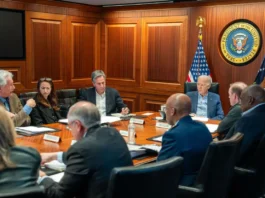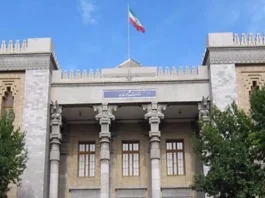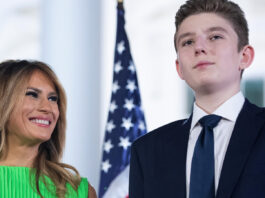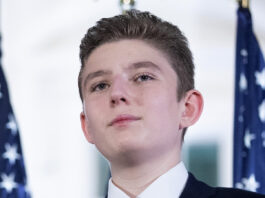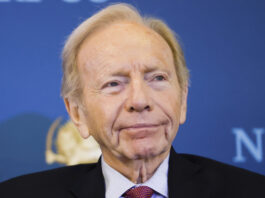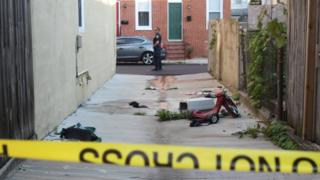

A person has been murdered in Baltimore almost every day this year, on average – more killings per capita than Chicago. Then a grassroots campaign made an audacious pledge – to orchestrate a 72-hour ceasefire. Did it work?
Day 1: Friday, 4 August
Erricka Bridgeford stands in the second storey window of the now-abandoned townhouse where she grew up and looks down on the street below, to the spot where Mike, a neighbourhood kid, fell over 30 years ago. That was the first time she’d ever seen someone shot.
“I actually heard him die, begging God he wouldn’t die,” she says. “I was 12.”
Since media outlets from across the country and globe started requesting interviews with her, asking her to explain her bold attempt to halt homicides for three days in a city where someone is murdered almost every day, Bridgeford started bringing them to her childhood neighbourhood in West Baltimore. After a local television crew packed up and left, the 44-year-old mediation trainer decided to push through the unlocked door of the townhouse and show her three children – aged 17 to 21 – around for the first time.

The family wanders the empty rooms in matching orange #BaltimoreCeasefire T-shirts. The air smells of urine, the walls are pocked with holes and smudged with the dirty outline of missing appliances. Upstairs, a used condom lies on the floor of what was once Bridgeford’s parents’ room.
“This is the house that made me,” she tells her children. “I feel sad that it looks like this. This looks like a light left out.”
The empty townhouse is a reflection of some of the underlying causes of the violence in Baltimore. From that second storey window, Bridgeford watched as drugs moved into her neighbourhood in the 1980s, and the families moved out.
Her friends started dropping out of school and selling dope. The grass turned to dirt. Along with the poverty and drugs came the guns – Mike was the first of nearly 20 people Bridgeford knew who’ve died from violence.
But on this particular morning, Bridgeford is in high spirits – it’s Friday, 4 August, day one of the “Baltimore Ceasefire”. Although the campaign is not affiliated with the Baltimore Police Department or any other arm of the city government, a trusted police contact has promised to text her if anyone is killed over the three days. Eleven hours in, the peace is holding.
“The air feels different,” says Bridgeford. “Even the sceptics are saying, ‘I hope it works.'”

The naysayers have some reason to feel that way. The idea for the weekend was set in motion after Bridgeford had a conversation with her 19-year-old son about the city murder rate, which is on track to be the worst in its recorded history and could rise to the highest in the country. Per capita, it’s already surpassed Chicago, Detroit and New Orleans.
Bridgeford bristles at some of the comments that have been made online, mocking her and the city for even needing such an effort.
“We want to purposefully have a pause and a sacred space where everybody’s intention is ‘nobody gets killed’. A cultural shift, so that it dawns on people that they can make this choice,” she says. “I hate the idea that people think ‘Oh, Baltimore is violent. Chicago is violent. Detroit is violent.’ These places are a reflection of America.”
Momentum built slowly, first on social media and word of mouth. The ceasefire has no single group or person as its leader. There is no celebrity headliner, no sponsorships or logos, save one: a stark black, white and red sign that reads “Baltimore Ceasefire: Nobody Kill Anybody for 72 Hours”. The idea is to convince the residents of the city to take ownership.
A large part of that involved canvassing the most violent parts of Baltimore, walking into the city’s open-air drug markets and making a plea to people working the corners to commit to a weekend free of violence.
One of the first people Bridgeford called was PFK Boom, co-founder of 300 Gangstas, a group of former gang members and ex-offenders who came together after the death of Freddie Gray in 2015 to police and advocate for themselves.
“It was a no-brainer,” Boom says of Bridgeford’s request for help. “I respect what she does. I seen her work, what she stands for, so that’s why I will accept that call and put my men, my reputation, my brand and all that [behind it].”
Bridgeford and the other organisers forbade media from observing the canvassing effort, but she says the outreach was successful enough that people started calling her independently to pledge their commitment.
“There have been people who have called to say ‘I am gang affiliated and I’m letting you know whoever I’m responsible for is chilling that weekend,'” she says. “If people get killed that weekend, even if we don’t know who did it, we know who didn’t do it.”

Bridgeford is 5 ft 2. Her right arm ends just below the elbow due to a condition she developed while in the womb. Her small stature, glasses and bubbly personality may contribute to the reasons some people write her off as naive. It doesn’t bother her.
“I grew up in West Baltimore. I’ve been raped twice. My brother got killed … I’ve lost my stepson. I’ve lost cousins. Two weeks ago, I lost somebody. Some years I go to two funerals in one day,” she says. “It’s not that I’m naïve. It’s just that my optimism is gangster.”
When the people she talks to scoff at her idea of a violence-free weekend, she turns it around on them.
“Are you saying you can’t keep your hood safe?” she asks them. “And the answer is always, ‘Oh, don’t worry about it, it’s going to be safe around here.’ … I understand male ego.”
After three months of canvassing, going on local radio shows weekly, meeting with organisations all over the city, plastering every telephone pole, every boarded up door and window with Baltimore Ceasefire posters and stickers, the weekend has arrived. There are dozens of public and private events planned throughout the city – cookouts, block parties, peace walks, art shows, vigils.
As one of the organisers flicks through her phone, she sees that dozens and dozens of her Facebook friends have changed their profile pictures to the Ceasefire logo.

And she’s noticing other things, too, little symbols. Like, for the first time all summer, she’s seeing dragonflies.
As the afternoon turns into evening, people are getting off work, the bars are filling and the parties are starting – it’s the real first test of the ceasefire.
Bridgeford and her children head for a busy intersection in southwestern Baltimore where a group of people are waving ceasefire signs, and passing flyers out to motorists. A city bus driver throws open the doors, grabs a Baltimore Ceasefire poster from somebody, and sticks it prominently in the windshield.
At some point a tall, thin man appears in their midst, dressed in papery green hospital scrubs – an ID bracelet on his tattooed wrist and EKG leads still stuck to his chest. He picks up a poster and holds it high in the air.
“I got shot last night,” he says, pointing to a piece of gauze taped to his right cheek. “I still got two bullets left in me.”
His name is Devrone McKnight – the 23-year-old was driving himself home from the hospital when he saw the ceasefire volunteers by the side of the road. He says he’s ashamed. He’d heard about the ceasefire effort but had made no plans to participate.
“Now I’m a victim,” he says. “From now on, I’m supporting this.”

He charges recklessly into the street in his socks and sandals, passing fliers and posters to motorists stopped at the red light. He seems almost frantic.
“Take it,” he pleads with drivers who won’t roll down their windows.
Some of the ceasefire events are more private, like on a quiet street called McCulloh across town.

Media playback is unsupported on your device
Brittany Oliver gathers with her family in front of the stoop where her uncle David Lamont Hill was gunned down exactly one year ago after he stopped to visit friends after work.
The family, dressed in matching T-shirts with Hill’s picture, silently place tea lights near the spot in the street where he fell after being shot seven times. Despite a $5,000 reward for information, no one has been arrested in connection with his death.
“We haven’t had a whole lot of information about who did it or what happened,” says Oliver.
In the last two years, not only have the number of homicides increased, but the number of cases closed by the Baltimore Police Department – either because they’ve been solved or the perpetrator is themselves killed or imprisoned on other charges – plummeted to one of the worst rates for large cities in the nation.
Since a low point of about 33% in 2015 when 242 homicides went unsolved, the city says the closure rate has rebounded to a little less than half. But that still means that the city has a backlog of hundreds of open murder cases, as new ones continue relentlessly rolling in.
When Oliver heard that the ceasefire weekend just happened to fall on the first anniversary of her uncle’s death, she arranged a canvas of the streets all around McCulloh.

“I thought I was going to be crying a lot more today,” she says.
“To be honest with you, that’s the ceasefire. For a long time, I wasn’t doing anything. This happened and I didn’t know what to do. When the ceasefire came up, it gave me an opportunity to find my voice again.”
Hours later, in a car park on the east side of Baltimore, the time is nearing midnight. Bridgeford, PFK Boom, and dozens of community members have gathered for an all-night barbecue. A team of lawyers is staying up all night to help anyone from the neighbourhood who stops by with criminal record expungements, child support issues, tenant and eviction situations – there’s even therapists on hand.
As the clock strikes midnight, a cheer rises up from the crowd. Rapper Kendrick Lamar’s voice booms from the speakers, singing “We gon’ be alright”.
“We just had 24 hours of no murders in Baltimore, ladies and gentlemen,” Bridgeford calls. “Who said we couldn’t do it? They said we couldn’t do one day! C’mon y’all, we can do another 24!”
Day 2: Saturday, 5 August

Forty-one hours into the Baltimore Ceasefire – after a day of peaceful marches, meat on the grill, basketball games – the spell is broken.
It started with rumours, chatter over the police scanner about a possible shooting in a neighbourhood known as Pigtown. Then the rumours become fact – a 24-year-old man was shot and killed while walking down the street. His friends picked him up and rushed him to the hospital, but he died not long after.
A woman with long dreads braided with purple cloth stands at her doorway just a few houses down from the crime scene, watching as the Baltimore police forensic team take pictures of the blood-stained sidewalk.
She’d heard about the ceasefire, seen Bridgeford on television. She’s dismayed that the weekend peace came to an end right at her front door. Neighbours says it’s the third shooting on this block in the last year and a half.
“Seven of my girlfriends have lost seven sons [in the last two months],” she says. “Never seen it this bad, never.”
“Tell ’em to put a [recreation centre] here,” calls a man in the street. “Y’all saying, ‘Ceasefire,’ but how do you ceasefire? You take the kids out of the streets. The kids got something to do other than being in the streets.”

Not long after the police remove the crime scene tape and begin opening the street back up, Erricka Bridgeford and her children arrive. She received the dreaded text message from her contact at the police department and rushed over, just as city firefighters are hosing the blood off the sidewalk.
Staring at the place where the man fell, Bridgeford wears a shattered expression. A television reporter with a microphone asks her for comment, but Bridgeford recoils and refuses.
“This means a lot to her,” her son Paul says quietly. “This was very likely to happen. We were hoping for the best, but expecting the worst.”
Slowly, more and more ceasefire participants begin arriving – a way to show the community support and to shake up the mundanity of these deaths. Bridgeford calls them over to join hands around the wet spot on the street. A few of the neighbours who’d already gone back to their normal Saturdays filter over, including the woman with the purple dreads.
As an ice cream truck rolls slowly past playing a tinny, lachrymose version of Korobeiniki, Bridgeford makes a point to pray not only for the young man, but also for his killer.
“They were not born with a gun in their hand. Their mother didn’t push them out saying, ‘I can’t wait ’til my baby grows up and shoots somebody on a ceasefire weekend,'” she says.
“What has been done to us?” she cries, her voice breaking. “What has been done to us?”

Darkness settles on the city. At another cookout on the west side, lawyers again gather to help fill out expungement paperwork. Brittany Oliver and some friends burn sage. PFK Boom and bow-tied members of the Nation of Islam stand guard in stony silence.
At 10pm, the police radios crackle to life again – there’s been another homicide, a 37-year-old man found dead on an eerily quiet block of south Baltimore.
In the car park, one of the ceasefire organisers who goes by Ogun ponders something a tough young man told him during their canvassing.
“He said a lot of people have a beef with someone where there’s no mediation. If they see this person somewhere, they’re not going to think,” he says. “That’s a problem that we can’t fix.”
There is no victory cry come midnight – the moment passes without comment. There are already articles posted online that the ceasefire has “collapsed” and Twitter trolls crow that the effort has failed.
Around 1am, Bridgeford climbs into the backseat of her car and lets her kids drive her home. In the dark, she switches on Facebook Live.
“That first one – it just knocked the wind out of me. Like it was someone I grew up with got killed. I still don’t know the people’s names,” she says.
“I am extremely blessed and extremely heartbroken.”
Day 3: Sunday, 6 August

In 2001, a 27-year-old man named Antoin Lamont McKnight was shot to death on a desolate corner in the Sandtown neighbourhood of west Baltimore. He was transported to Maryland Shock Trauma Center, where he died of multiple gunshot wounds. His killer was never caught.
Sixteen years later, Antoin McKnight’s son Devrone was rushed to the same hospital with a gunshot wound to the face. Unlike his father, Devrone survived.
On the final morning of the ceasefire weekend, he sits in his mother’s living room, recalling the moment three days ago when a man charged him and his uncle as they sat on the porch. There’s a picture of his father on a desk directly beneath a bullet hole punched through the wall from the attack.
He was only seven years old when his father was murdered, but Devrone remembers carving pumpkins with him on Halloween, he remembers birthday parties. He doesn’t know much about what his dad was involved in, but concedes that like many Baltimoreans, he may have been tangled up in some type of criminal activity.
“I didn’t want to be like that so I did everything in my power to stay away from the street life,” he says.


Devrone works at the same the hospital where his father died and attends Morgan State University, studying construction management. Before this point, he’d figured if he just went to school, went to work, and minded his own business, he’d never end up like his father.
But the bullet fragments embedded in his face and neck prove otherwise – the shock of that fact sent him running into the street on the first day of the ceasefire in his paper thin hospital garments, trying to convince strangers to care.
In 2017, 404 people have been shot and survived according to figures from the Baltimore Police Department. McKnight feels extraordinarily lucky that, unlike the two men who died on Saturday, he has the opportunity to get involved.
“I just want to be the voice of the victim who can talk right now. It’s sad that two days into the ceasefire programme somebody else got killed,” he says.
“I kinda feel sorry and bad because I didn’t react sooner.”
Devrone and his mother head for church, where he thanks God for sparing his life and prays for the hands of the surgeon who will eventually be tasked with removing the bullet still lodged in his neck, close to an artery. Then he heads to downtown Baltimore, where one of the final marches of the weekend is taking place.

About 150 marchers gather at the foot of the 234-foot-tall Phoenix Shot Tower, a 19th-Century edifice where molten lead was dribbled from the top into a cold water bath at the bottom – an early technique for fashioning bullets.
They march solemnly past Baltimore City Hall, and file into a television studio draped in black curtains where the organisers and marchers take turns reading the names of the more than 200 men and women who were murdered in 2017, beginning on the very first of the year.
Sheamon Pearlie
James Williams
Davonte Jackson
Jamal Washington
Timothy Stephens
Men with hand drums strike two beats after each name.
Charles Frazier
Tyrell Matthews
Carlos Montgomery
Channon Simpkins
Tony Tingle

As name after name after name is called in the stuffy room, people start to cry. There are sighs at the reading of “unidentified man”.
Timothy Campbell
Tyione Brown
Emmanuel Johnson
Marco Stevenson
Antonio Griffin
Finally, Bridgeford leads the crowd in reading two final names, which are still only partially known, from Saturday:
Trey
Donte, also known as EA

At midnight that evening, the official close of the ceasefire weekend, Bridgeford is home, exhausted, eating pizza. But she is back in high spirits.
“No murders happened in Sandtown. People who called and said my crew won’t – their crew didn’t,” she says. “What Baltimore was able to pull off was a 41-hour stretch of no murder, and then from 10 o’clock last night to 12 am now, that’s another 26 hours with no murder. But that five hours in between is what I want you to remember.”
The next day, a meeting called Baltimore Ceasefire 365 is planned. The organisers are adamant that their work does not end with the ceasefire – one of the first orders of business is to help pay for the burials of the two men who died.
Although six people were shot over the course of the weekend, two fatally, Bridgeford still declares the ceasefire a success. For one single weekend, she says, some of the most beaten-down communities in Baltimore allowed themselves to hope.
“I was born with one hand … I’ve had to experience what it’s like to be Baltimore. To look broken and have to find wholeness,” she says.
“Don’t be numb … We need to remember that feeling of how it was when we cared.”
Early the next morning, the Baltimore Police Department finally releases the names of Saturday’s victims:
Lamontrey Tynes
Donte Johnson
They also report yet another murder, the city’s 212th.

.







